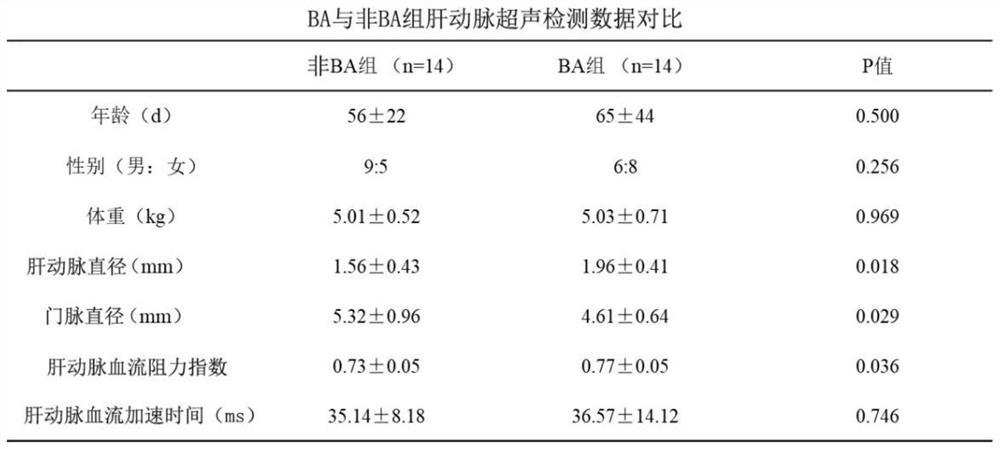Method based on gene/protein as diagnostic marker and therapeutic target for biliary atresia and application thereof
A technology of biliary atresia and treatment target, applied in the biological field, can solve problems such as inability to treat biliary atresia, and achieve the effects of improving hypoxia and bile duct injury, improving liver survival rate, and slowing down the progression of the disease.
- Summary
- Abstract
- Description
- Claims
- Application Information
AI Technical Summary
Problems solved by technology
Method used
Image
Examples
Embodiment 1
[0052] The present invention provides a method based on gene / protein as a diagnostic marker and therapeutic target for biliary atresia, comprising the following steps:
[0053] ① Summarize the structural characteristics of the human BA hepatic artery system. In order to understand the structural characteristics of the human hepatic artery system, the main hepatic artery and the level of resistance arterioles in the intrahepatic portal area were selected for observation. The former was measured by Doppler ultrasound and indocyanine green vessels contrast methods, the latter with the aid of histological measurements;
[0054] ② To study the expression of Notch in the liver of human BA and animal models. In order to study the expression of Notch from multiple levels, the detection methods used RT-PCR, Western-blots, OPAL multispectral staining, and primary culture and staining of smooth muscle cells;
[0055] ③ Diverse interventions targeting Notch3 in animal models. Specificall...
Embodiment 2
[0078]Observation method of spider-like vascular sign (HSST sign) on the liver capsule surface: HSST sign observation and photo collection can be completed under direct vision of the laparoscopic system. In this example, after connecting the laparoscope and before the free gallbladder operation, photos of the liver and diaphragm were collected. Image 6 It indicated that the liver histopathology of BA children less than 1 month old did not show obvious fibrosis, but showed the same typical spider-like vascular signs on the liver capsule surface as 2-month-old BA children.
[0079] Rotavirus (RRV)-induced mouse model method and mouse liver capsule surface vascular sign observation method: adult wild-type SPF grade BALB / c mice (7w) were bred according to the ratio of male to female 2:1 or 3:1, each The body weight changes of pregnant mice were recorded daily, and the production situation was expected to be checked every day during the expected period of delivery for timely proce...
Embodiment 3
[0082] In step ② of Example 1, "Study on the expression of Notch in the liver of human BA and animal models", the expression detection method of Notch3-Hey1 pathway exists in the liver of human BA: RT-PCR and Western-blot are used in the quantitative detection method. Among them, RT-PCR detects Notch1-4 in human liver tissue, and its main downstream target genes Hes1, Hes5, Hey1, Hey2, HeyL. Figure 8 Map showing abnormally high expression of the Notch3-Hey1 pathway in human BA liver. The primer sequences are as follows:
[0083]
[0084] First, total RNA is extracted from the tissue, and cDNA is produced by conventional reverse transcription. The specific steps are:
[0085] 1) Take liver tissue treated with RNAlater and frozen in -80 refrigerator, take 0.05g of it and grind it in a homogenizer, add 1ml Trizol to fully homogenize it, and transfer the homogenate to a 1.5ml EP tube;
[0086] 2) Add 0.2ml of chloroform to each tube, shake rapidly for 15s and let it stand fo...
PUM
 Login to View More
Login to View More Abstract
Description
Claims
Application Information
 Login to View More
Login to View More - R&D
- Intellectual Property
- Life Sciences
- Materials
- Tech Scout
- Unparalleled Data Quality
- Higher Quality Content
- 60% Fewer Hallucinations
Browse by: Latest US Patents, China's latest patents, Technical Efficacy Thesaurus, Application Domain, Technology Topic, Popular Technical Reports.
© 2025 PatSnap. All rights reserved.Legal|Privacy policy|Modern Slavery Act Transparency Statement|Sitemap|About US| Contact US: help@patsnap.com



